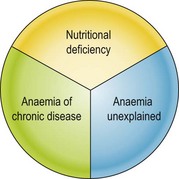46 Anaemia is a common clinical problem in the elderly. The prevalence rises rapidly after 50 years and approaches 20% in people aged over 80 years. In general, one third of cases will have an identifiable nutritional deficiency (iron, vitamin B12 or folate) (Fig 46.1). Where iron deficiency is the cause of anaemia it is often secondary to gastrointestinal blood loss, and underlying bowel pathology (e.g. colonic carcinoma) should be excluded. Another third of cases have the anaemia of chronic disease. These patients have an obvious chronic inflammatory condition (see p. 36) and will often have a measurable acute phase response (e.g. elevated C-reactive protein). In the final third of elderly patents, there is no clear cause for the anaemia (sometimes termed ‘anaemia unexplained’). This entity is a diagnosis of exclusion and has been the focus of much recent interest. A few cases may be explained by myelodysplastic syndrome or other rarer causes of anaemia but it is probably mainly due to a combination of age-related suppression of erythroid colony formation, insensitivity to erythropoietin and impaired iron utilisation.
Haematology in the elderly
Anaemia
Oncohema Key
Fastest Oncology & Hematology Insight Engine




